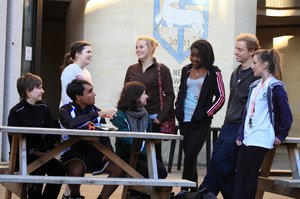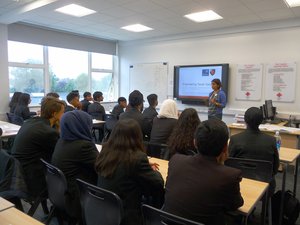Detailed admissions statistics for 2013-17 are published by the University
The statistics are broken down into chapters covering
overall application numbers, nationality and country of residence, UK region,
disadvantage, school type, gender, ethnicity and disability. The report also
includes information for each of the colleges and for the 25 largest courses,
aggregated for the three years 2015-17. (This aggregation prevents small yearly
figures giving an inaccurate or misleading picture.)
Across the University
Overall, the report tells a story of progress for UK students from under-represented backgrounds applying to Oxford in the five years from 2013 to 2017:
- The proportion from state schools has increased from 56.8% to 58.2%.
- The proportion identifying as Black and Minority Ethnic (BME) has risen from 13.9% to 17.9%.
- The proportion from socio-economically disadvantaged areas rose from 6.8% to 10.6%.
- The proportion from areas of low progression to higher education rose from 9.5% to 12.9%.
- The proportion declaring a disability rose from 5.6% to 7.7%.
- The mix of men and women has fluctuated, with men outnumbering women in most years but more women admitted than men in 2017.
At St John's At St John’s we’re committed to admitting students of the
highest academic potential, regardless of their background, and supporting them
to succeed here. We welcome diversity in our student body, and are proud that our
students do indeed come from a richly diverse mix of backgrounds. There is
always more to be done to ensure that the brightest students make successful
applications to the university, and the College has a strong sense of purpose
in striving to increase the proportion of UK undergraduates from groups
traditionally under-represented at Oxford.
At St John’s we’re committed to admitting students of the
highest academic potential, regardless of their background, and supporting them
to succeed here. We welcome diversity in our student body, and are proud that our
students do indeed come from a richly diverse mix of backgrounds. There is
always more to be done to ensure that the brightest students make successful
applications to the university, and the College has a strong sense of purpose
in striving to increase the proportion of UK undergraduates from groups
traditionally under-represented at Oxford.
The statistics in the report show that St John’s work in this area has produced some encouraging results.
Schools In 2015-17, 58.8% of the UK-based undergraduates we admitted were from state
schools. In 2017, 28% of the undergraduates admitted were from overseas or from special or language/arts schools
in the UK. Many countries are represented in our student body; in 2017 we made
136 offers for undergraduate places which included students of 22 different
nationalities. Over the past five years, we have been closing the gap between
the success rate of applicants from state vs independent schools, so that in
2017 the state school success rate for applicants who applied directly to St
John’s was 25% and the independent schools success rate 26%. From other schools
and overseas it was 18%, well above the university average of 11%. St John’s is proud of the progress that has been made in
ensuring that if excellent candidates apply to the College and we are unable to
place them, they are considered for places at other colleges in accordance with
the Common Framework.
In 2015-17, 58.8% of the UK-based undergraduates we admitted were from state
schools. In 2017, 28% of the undergraduates admitted were from overseas or from special or language/arts schools
in the UK. Many countries are represented in our student body; in 2017 we made
136 offers for undergraduate places which included students of 22 different
nationalities. Over the past five years, we have been closing the gap between
the success rate of applicants from state vs independent schools, so that in
2017 the state school success rate for applicants who applied directly to St
John’s was 25% and the independent schools success rate 26%. From other schools
and overseas it was 18%, well above the university average of 11%. St John’s is proud of the progress that has been made in
ensuring that if excellent candidates apply to the College and we are unable to
place them, they are considered for places at other colleges in accordance with
the Common Framework.
Socio-economic disadvantage
In 2015-17, the proportion of students admitted to College from ACORN
categories 4 and 5 (a postcode-based tool to show areas of socio-economic
disadvantage) was 12.3%, well above the university average of 9.1% for those three years. The
proportion of students from POLAR quintiles 1 and 2 (areas of low progression
to higher education) was 13.8%, in the context of a university average of 11.7% for those years.
Gender and ethnicity
In 2015-17, 51.3% of our undergraduate admissions were women, against the
university average of 48.8% for those years. The proportion of BME students was 17.2%; the
university average was 16.1% for those years.
Support at St John's
Once our students arrive, we want to support them and help them thrive, not
only in their studies but also in their personal development. Their welfare is
our priority, and we have dedicated Fellows for Welfare, for Women, for Ethnic
Minorities and for Equality. Social gatherings such as International Evening dinners, and one-to-one meetings, provide regular support, enhanced by equality
and diversity training for staff.
Financially, a range of bursaries and scholarships support students who need them, while grants are available for all students for buying books and equipment, and for travel. In the vacations we can also provide financial support to enable students to take up internships and work experience placements, valuable preparation for their future careers. Our reasonably priced accommodation, available for all years of undergraduate study, protects students from the high rental costs in the city of Oxford.
Access and outreach
 Key to our success in attracting students from groups traditionally
under-represented at Oxford is our Access and Outreach programme. We work with
schools in our link regions of Ealing and Harrow, Brighton & Hove, East
Sussex and West Sussex, regularly hosting groups of pupils and their teachers in
College for days which may include academic taster sessions, tours of the
College, or an Oxbridge Information session to assist with the application
process. Members of the Access team visit schools in our target regions to
provide information, advice and guidance on applying to highly selective
universities. An annual student roadshow takes the story directly to them,
through our wonderful team of student ambassadors.
Key to our success in attracting students from groups traditionally
under-represented at Oxford is our Access and Outreach programme. We work with
schools in our link regions of Ealing and Harrow, Brighton & Hove, East
Sussex and West Sussex, regularly hosting groups of pupils and their teachers in
College for days which may include academic taster sessions, tours of the
College, or an Oxbridge Information session to assist with the application
process. Members of the Access team visit schools in our target regions to
provide information, advice and guidance on applying to highly selective
universities. An annual student roadshow takes the story directly to them,
through our wonderful team of student ambassadors.
Our Teachers Study Week take place each summer in College. Typically 20-30 teachers from the state sector come to Oxford to research a subject of their choice that contributes to their professional development. During this time the teachers have an opportunity to experience student life in Oxford as they stay in student accommodation, eat in the dining hall and make use of the extensive library facilities. Where possible, the teachers can meet the tutors working in a similar subject area.
 Our Inspire Programme was launched in 2017 as a new
initiative focused on our two London boroughs. It is a carefully structured
programme that takes students from Years 9 to 13 in non-selective state schools
through the process of developing their academic aspirations, challenging and
informing themselves, and growing in confidence so they can make effective
applications to top universities like Oxford. Typical activities include:
academic talks from current Oxford tutors; a 4-day summer school at College
which includes an opportunity to present a research project of their choice;
workshops for teachers to guide their pupils through the university application
process; study skills sessions; aspiration days; subjection exploration
activities.
Our Inspire Programme was launched in 2017 as a new
initiative focused on our two London boroughs. It is a carefully structured
programme that takes students from Years 9 to 13 in non-selective state schools
through the process of developing their academic aspirations, challenging and
informing themselves, and growing in confidence so they can make effective
applications to top universities like Oxford. Typical activities include:
academic talks from current Oxford tutors; a 4-day summer school at College
which includes an opportunity to present a research project of their choice;
workshops for teachers to guide their pupils through the university application
process; study skills sessions; aspiration days; subjection exploration
activities.
We are developing an evaluation programme for our outreach initiatives, to ensure they have maximum impact where they are most needed, and while there is still much to do we are continually working hard to develop our work in this area, and to reinforce the message that the University of Oxford is open to talented young people regardless of their background.
Find out more about the Annual Report on Access and Admissions
Find out more about our Inspire Programme
Find out more about our work with schools